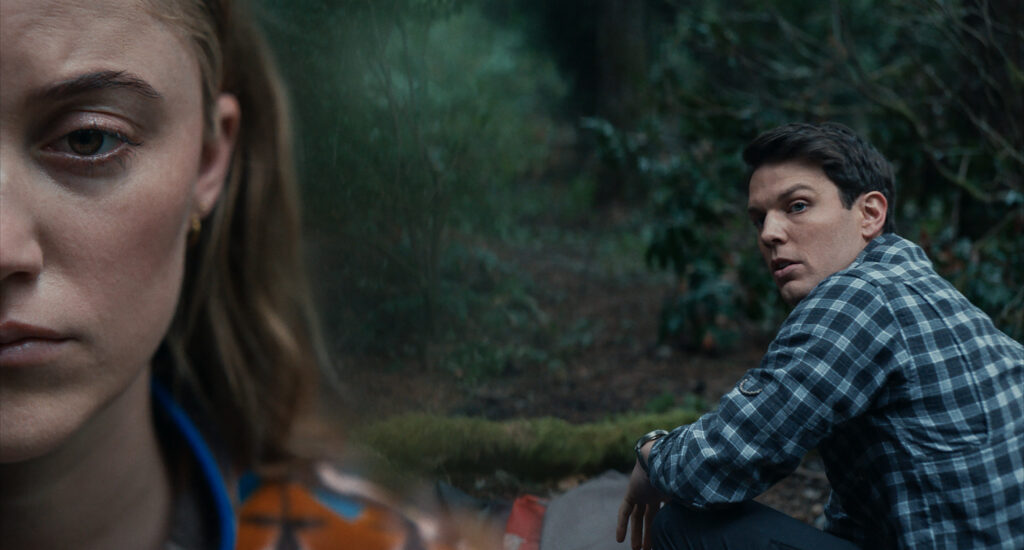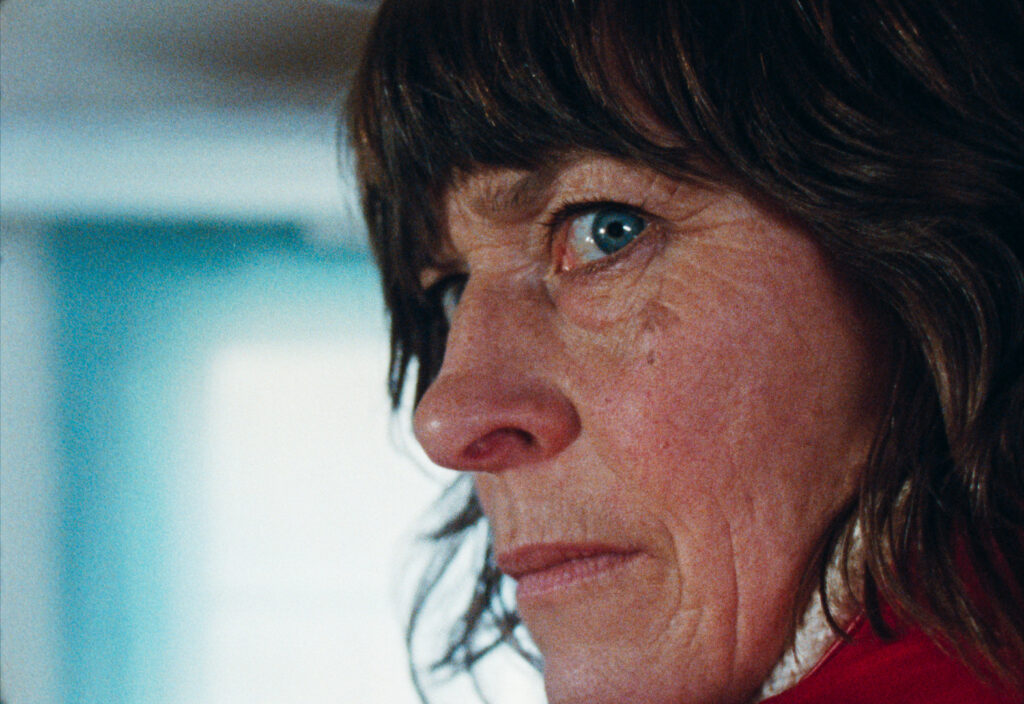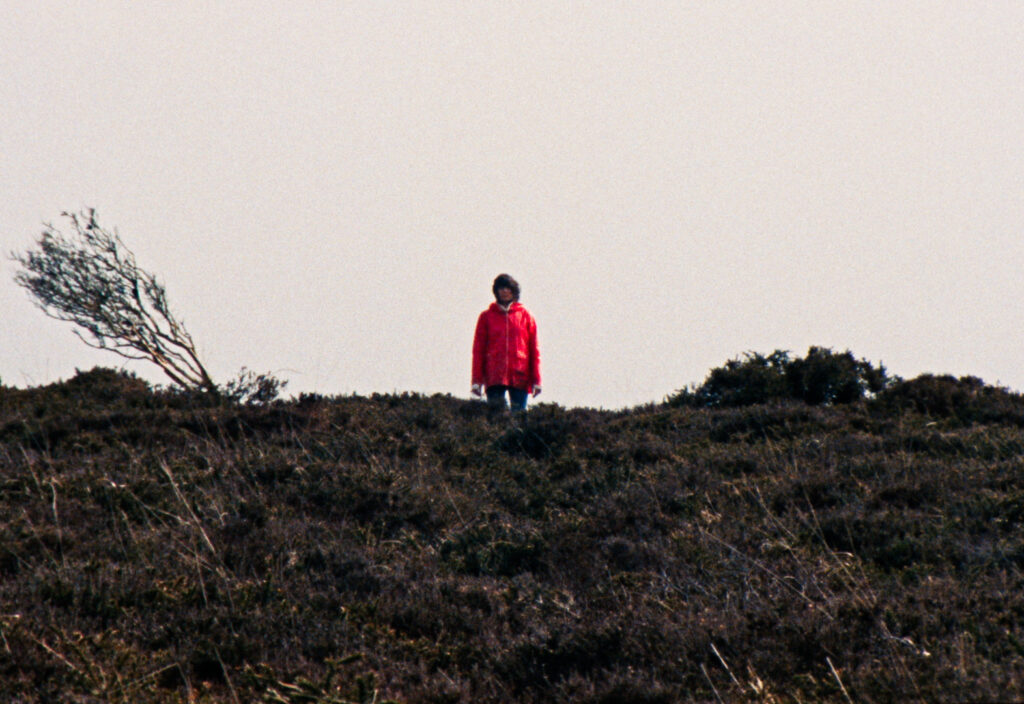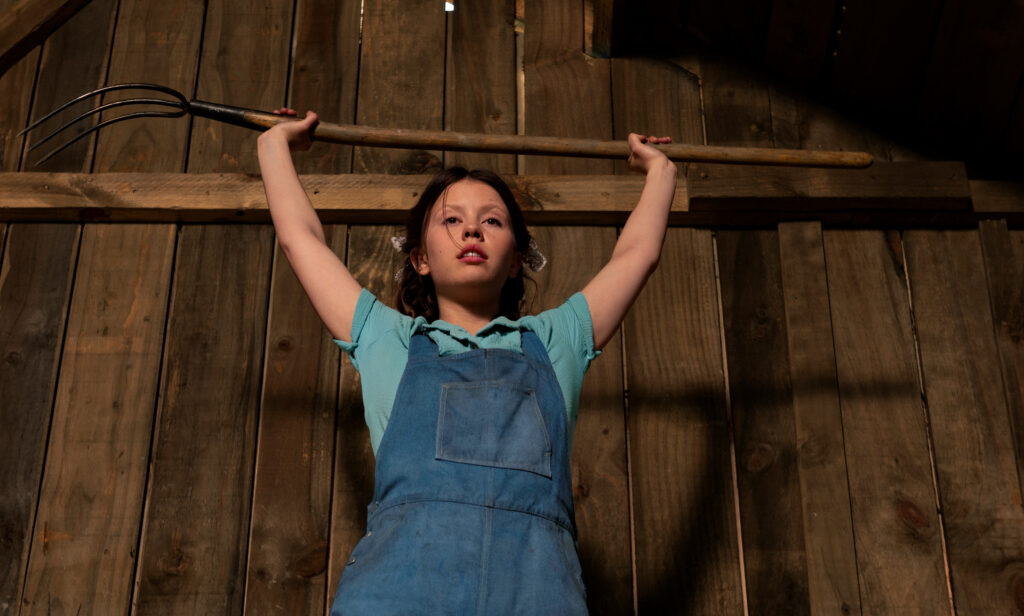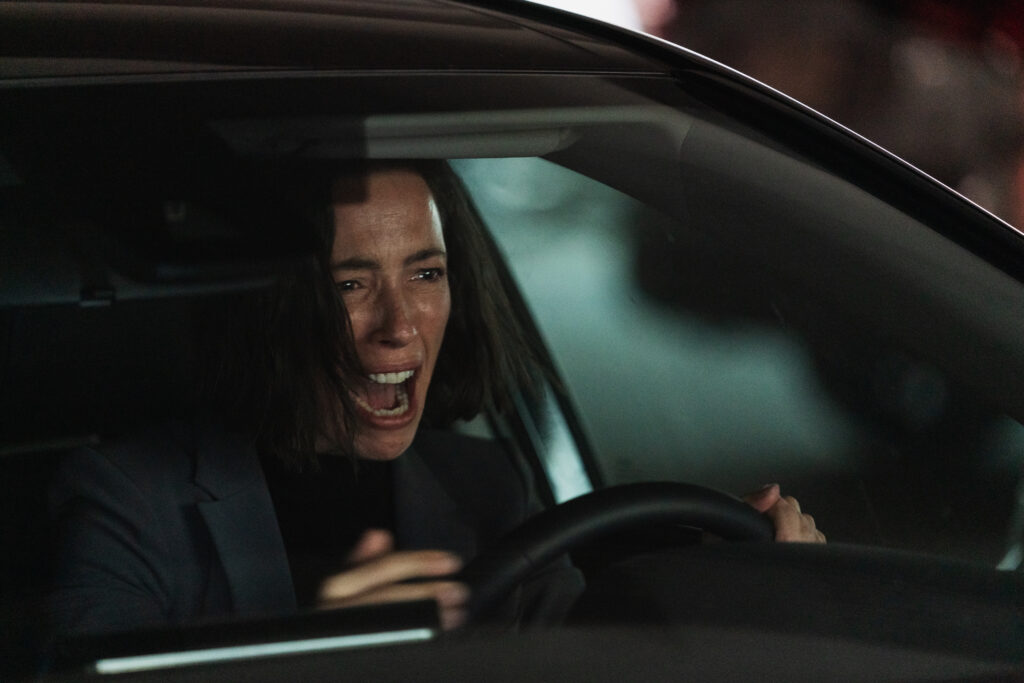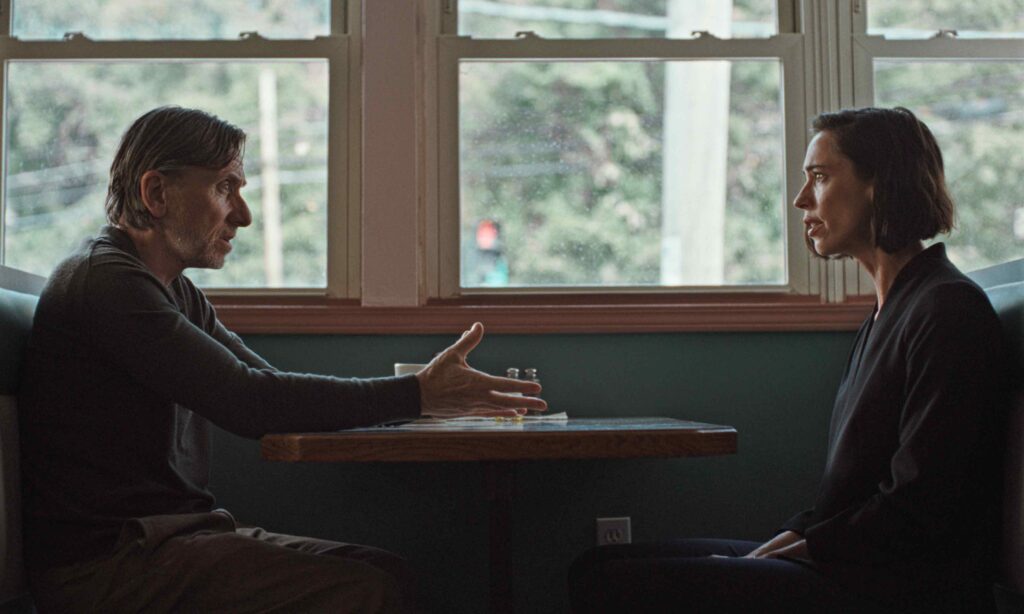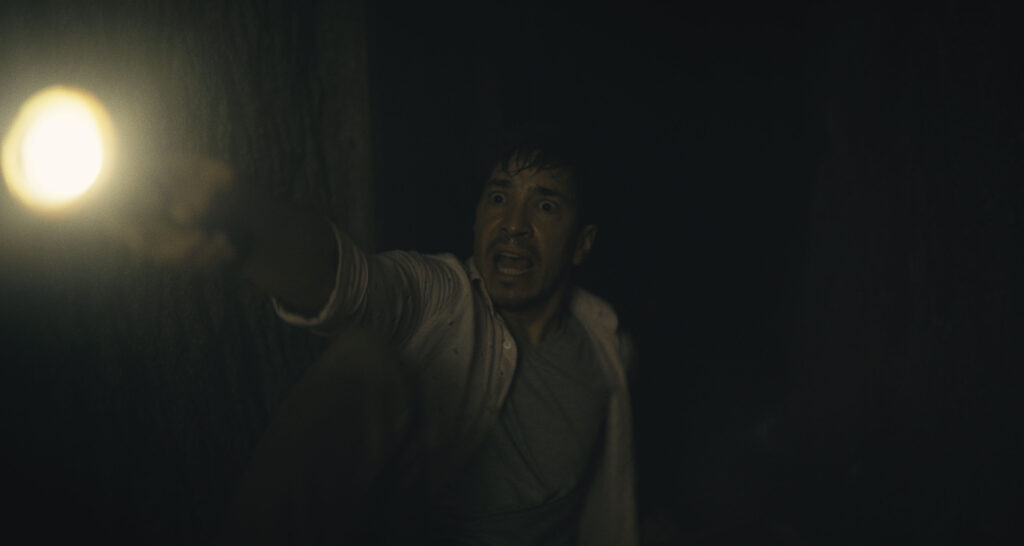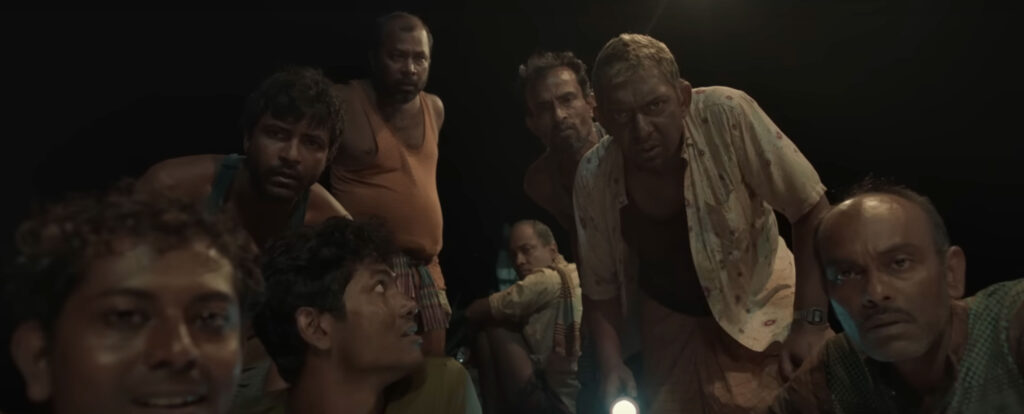October 24, 2022
by Carla Hay

Directed by Fabrice Eboué
French with subtitles
Culture Representation: Taking place in Melun, France, the horror comedy film “Some Like It Rare” features a predominantly white cast of characters (with some black people and people of Middle Eastern heritage) representing the middle-class and working-class.
Culture Clash: After a married couple’s butcher shop is vanadalized by vegan animal-rights activists, the spouses get revenge by becoming cannibal serial killers who mostly target vegans.
Culture Audience: “Some Lke It Rare” will appeal mainly to people who are interested in watching dark horror comedies that are satires of social issues.

“Some Like It Rare” is a brutally funny satire that lampoons the cultural divide between meat consumers and vegans. A horror comedy about cannibal serial killers could have been mishandled, but “Some Like It Rare” is a skillful balance of macabre and mirth. It goes without saying that viewers who get easily squeamish by cannibal horror should use their own discretion on whether or not to watch “Some Like It Rare,” because this movie has some very bloody and graphic scenes that are not for overly sensitive viewers.
“Some Like It Rare” is a memorable showcase for the talent of Fabrice Eboué, who directed the movie and is one of the co-writers and main stars. Eboué co-wrote the film with Vincent Solignac, who is a fellow prolific actor/screenwriter. Through its very dark comedy, “Some Like It Rare” has incisive observations about how different perceptions of what type of life is valued the most can affect the way that people treat each other and also perceive themselves. “Some Like It Rare” can occasionally get very repetitive, but the story moves along at a pace that should keep viewers interested.
In “Some Like It Rare” (which takes place in Melun, France), Eboué portrays Vincent Pascal, a mild-mannered butcher who co-owns and co-operates a butcher shop called Boucherie Pascal with his wife Sophie Pascal (played by Marina Foïs), who is much more assertive and outspoken than Vincent. (“Some Like It Rare” was actually filmed in Le Havre, France.) Vincent and Sophie have hit a rough patch in their marriage, where their sex life has become non-existent. Adding to this tension, their butcher shop is financially struggling.
Sophie isn’t shy about expressing how unhappy she is in the marriage. She complains to Vincent that he gives more attention to their shop’s meat and to their pit bull Chubster than he gives to her. Sophie tells Vincent one day that she thinks that they should separate. He doesn’t put up much resistance to this idea. However, before Vincent and Sophie actually go through with the separation, something happens that will change their lives forever.
One day, a group of four people wearing masks and white jumpsuits storm into Boucherie Pascal, splash red paint all over the shop, and yell at Vincent and Sophie for being murderers for selling meat. Vincent chases them out of the store and gets into a tussle with a few of them. One of the men’s masks comes off, so Vincent is able to see his face. Before running away and getting into their van, one of the men in this group of vandals yells, “Vegan Power!” It’s another obvious indication that these are extreme vegan activists.
Vincent and Sophie don’t report this crime to police. Later, Sophie and Vincent have dinner at the home of their best friends Marc Brachard (played by Jean-François Cayrey) and Stéphanie Brachard (played by Virginie Hocq), a materialistic and pretentious couple who love to brag about how they’re doing financially better than Vincent and Sophie. Marc and Stéphanie are also in the meat-selling business, but they have a number of profitable shops, compared to Vincent and Sophie, who are barely surviving financially with their one shop.
Sophie confides in Stéphanie that a bank recently turned down Vincent and Sophie’s request for a loan. It’s just one more reason for arrogant Marc and Stéphanie to have the dinner conversation revolve around Marc and Stéphanie yammering on about their recent luxury vacations, their six-figure household income, and how they’re thinking about buying a home in Morocco. During this dinner, Marc gives a rifle to Vincent as a gift, but Vincent is reluctant to take the rifle, since he doesn’t have a gun permit. Marc makes derogatory comments about black people and hipster vegans, and then he tries to show that he’s macho by taking the rifle and shooting an inflatable toy duck in the swimming pool.
While driving home from this emotionally draining dinner party, Vincent and Sophie are on a deserted road when the car accidentally hits a man (played by Alexis Pujol), who suddenly appeared in front of their car. He is instantly killed. And when Vincent and Sophie get out of the car, they see that the man they hit is wearing the same white jumpsuit as one of the vandals who invaded the store. Vincent instantly recognizes him as the man whose mask came off.
Vincent’s guilt about this accident quickly turns to smugness. Vincent quips about the man dying instantly: “If he had eaten meat, he might have been tougher.” Sophie is a true-crime aficionado who knows a lot of trivia about serial killers. She suggests to Vincent that they not report the crime, dismember the body, and let the police think that this death was caused by a serial killer name Michel Francois, a city hall worker who is known for dismembering his victims and leaving the body parts around the city. It’s a shaky plan at best, but Vincent goes along with it.
After the body is dismembered, Vincent and Sophie get rid of the body parts by secretly grinding them up and selling these remains in the butcher shop as “Iranian pork.” When customers ask where Sophie and Vincent get this “Iranian pork,” Sophie and Vincent say that their supplier is a farmer whose identity they want to keep a secret because they don’t want their competition to find out. The “Iranian pork” becomes a big hit in the community, and the butcher shop starts to thrive financially.
But it results in Vincent and Sophie needing to get more of this “special meat,” which they try for themselves and find out that they actually like to eat human flesh. And so, their serial killing begins, as Vincent and Sophie decide to target vegans (especially vegans who come across as self-righteous and preachy) as their murder victims. Vincent (using the rifle that Marc gave him and meat cleavers) does the actual killing, while Sophie eggs him on and is usually the one who decides who the next victim will be. During this murder spree, Vincent and Sophie sometimes pretend to be vegan activists to infiltrate the places where vegan activists congregate.
Around the same time that Vincent and Sophie begin their secret lives as cannibal serial killers, their teenage daughter Chloé Pascal (played by Lisa Do Couto Texeira), a college student who doesn’t live in the same household, introduces her new boyfriend to her parents. He’s an agronomy student named Lucas (played by Victor Meutelet), who is a very strict vegan. Chloé announces to her parents that she’s now become a vegan too. Vincent and Sophie meet Lucas for the very first time in a comical scene where Lucas is invited over for dinner in the Pascal home, but he rejects every dinner item that is served because it violates his vegan standards.
Over time, Vincent and Sophie’s shared bonding about their secret life puts the spark back in their marriage, and their sex life is revived. Vincent and Sophie call off their planned separation and decide to stay together. But at what cost? Vincent is alarmed to find out how far Sophie is willing to go to get “fresh meat.”
For example, Sophie has no problem with wanting to murder women and children, but Vincent is initially appalled by this idea. Sophie is also more cold-hearted when it comes to the mostly male victims whom they choose to kill. For example, Vincent and Sophie target an overweight man named Winnie (played by Tom Pezier), but Vincent hesitates to kill him when Winnie says he was bullied as a child as he begs for his life. Sophie is unmoved by this childhood sob story, and Winnie becomes one of the couple’s murder victims.
“Some Like It Rare” makes a lot of obvious comparisons between what Vincent and Sophie do to what human hunters do when they hunt for animal meat. The movie also has an intentionally ironic montage sequence that juxtaposes archival footage of wild animals killing and eating other wild animals with footage of the murderous activities of Vincent and Sophie. As time goes on, Sophie gets more fanatical during the murder spree, but the story won’t necessarily go in the direction that some viewers might think it will go. Real-life French TV host Christophe Hondelatte plays a version of himself, as a TV host of a true-crime news show that talks about a lot of the serial killers who fascinate Sophie.
As this serial-killing couple, Eboué and Foïs show a talented ability to bring the right tone to this very dark parody that walks a fine line between being clever and being crass. Beyond the murder aspect of the story, “Some Like It Rare” also explores what greed and financial desperation can do to people. And although Vincent and Sophie are equally guilty of these murders, there’s a point in the movie where it becomes evident that their loyalty to each other will eventually be tested in a big way.
“Some Like It Rare” doesn’t take a stance either way in support of meat eating or veganism. Rather, it shows that people are capable of extreme ways of defending their choices of what to eat and drink, as well as how to possibly profit from those choices. “Some Like It Rare” poses these provocative questions that can cause debate: “What kind of vegan or vegetarian thinks it’s okay to commit violence against humans in the name of animal rights? Why do meat eaters consider certain animals as acceptable to eat and not other animals?” The answers, just like who might enjoy watching “Some Like It Rare,” really depends on the individual person.
Brainstorm Media released “Some Like It Rare” in select U.S. cinemas on October 7, 2022. The movie was released on digital and VOD on October 14, 2022. “Some Like It Rare,” originally titled “Barbaque” (French for “barbeque”), was released in France in 2021.

